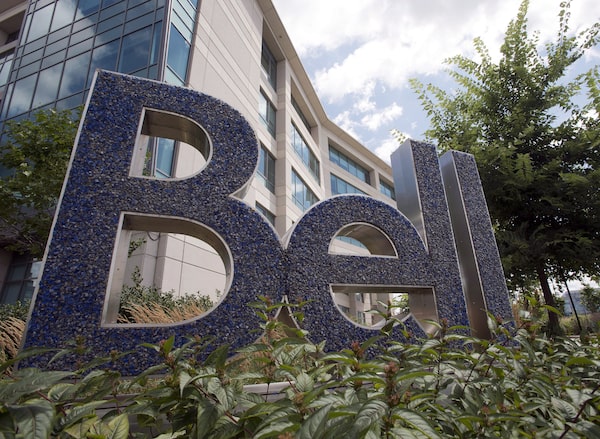
Bell Canada head office on Nun's Island in Montreal on August 5, 2015.Ryan Remiorz/The Canadian Press
Canada’s telecom regulator will largely allow big phone and cable companies to maintain the rates they charge smaller internet service providers for access to their broadband networks, after the big telecoms complained lower prices the commission announced nearly two years ago would discourage them from investing in new infrastructure.
In a decision published Thursday afternoon, the Canadian Radio-television and Telecommunications Commission (CRTC) said it is reversing its August, 2019, decision, which slashed wholesale broadband rates, because information it received during its review caused the regulator to doubt the accuracy of that ruling.
“We identified a sufficient number of errors ... to bring into doubt the correctness of that decision,” Ian Scott, chief executive and chairman of the CRTC, said in an interview. “What you have today is, following that examination, what we believe are the just and reasonable rates for that service.”
CRTC decision on wholesale internet rates expected Thursday
Consumer advocates and independent internet service providers (ISPs) criticized the decision, which they said will result in higher prices and less choice for consumers.
“The CRTC basically reversed a decision that they spent over three years making, with thousands of pages of submissions,” said Matt Stein, CEO of independent ISP Distributel Communications Ltd. and chairman of the Competitive Network Operators of Canada, an industry group representing independent ISPs.
“It just seems so bizarre. How could the CRTC – the same chair and many, if not most, of the same commissioners – flip-flop so far from the statements in 2019 where they said the rates were not just and reasonable?” Mr. Stein added.
To encourage competition in the internet market, the CRTC requires the large phone and cable companies to sell network access to independent internet service providers (ISPs) at regulated rates. Those third-party operators, which include Teksavvy Solutions Inc. and Distributel, then sell internet service to their own customers.
In August, 2019, the CRTC lowered the rates the larger telecoms are able to charge and ordered them to make retroactive payments – at the time totalling an estimated $325-million, according to court documents – to third-party operators to compensate for the higher rates they had been paying since 2016.
However, the lower rates and the retroactive payments have failed to materialize, as the large telecoms have pursued every avenue available to them in an effort to have the decision overturned. The phone and cable companies appealed the ruling to the federal court, the federal cabinet and to the CRTC.
Last summer, cabinet declined to overturn the CRTC’s August, 2019, ruling but sided with the large telecoms by commenting that the reduced rates could stifle investment in telecom networks.
The Federal Court of Appeal, meanwhile, dismissed the case last September, saying that the issues presented by the phone and cable providers were of “dubious merit.”
One of the changes that the CRTC is making to the 2016 rates is removing a 10-per-cent markup that the telephone companies – Bell Canada, SaskTel and Telus – were able to charge. The CRTC’s decision is retroactive to 2016, which means the phone companies will have to pay back the money they collected through that supplementary fee.
John Lawford, executive director of the Public Interest Advocacy Centre, said that both the federal government and the telecom regulator have “lost their nerve” when it comes to dealing with the major internet providers. “They backed away from a fair wholesale rate that would have increased consumer choice and lowered internet prices for Canadian consumers,” Mr. Lawford said in a statement.
Bell spokesperson Nathan Gibson called the decision a positive development that will allow telecoms to make major infrastructure investments. “We’re pleased the CRTC has recognized the critical role that network builders play in connecting Canadians everywhere,” Mr. Gibson said in an e-mail.
The CRTC said its decision aims to provide greater clarity to the industry and to allow the regulator to shift its focus to developing a new wholesale broadband model. Under the current “aggregated” system, the large telecoms are required to sell to third-party operators services which bundle access to the “last mile” – the connection into customers’ homes – along with transport of data to and from the broader internet.
Under the new “disaggregated model,” competitors will acquire access only to the last mile, and then will be able to either provide their own data transport or lease it from other service providers. The new model “encourages investment in facilities, reduces the areas that are subject to mandated regulation and has a greater reliance on the competitive market,” Mr. Scott said.
The final terms and rates for the disaggregated model are currently under consideration by the CRTC.
Your time is valuable. Have the Top Business Headlines newsletter conveniently delivered to your inbox in the morning or evening. Sign up today.